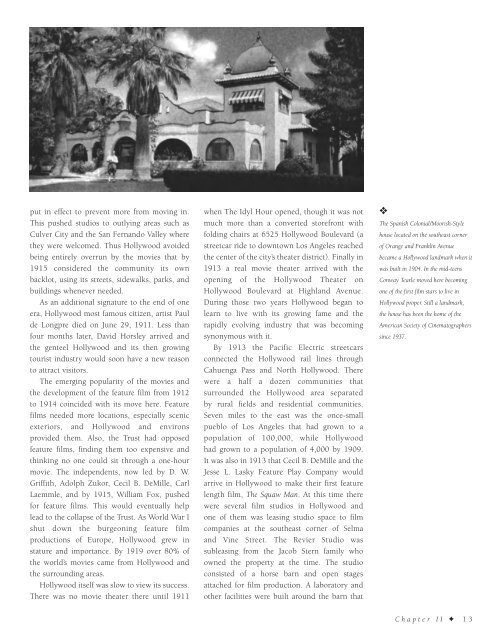Historic Hollywood
An illustrated history of the City of Hollywood,California, paired with the histories of companies, families and organizations that make the region great.
An illustrated history of the City of Hollywood,California, paired with the histories of companies, families and organizations that make the region great.
You also want an ePaper? Increase the reach of your titles
YUMPU automatically turns print PDFs into web optimized ePapers that Google loves.
put in effect to prevent more from moving in.<br />
This pushed studios to outlying areas such as<br />
Culver City and the San Fernando Valley where<br />
they were welcomed. Thus <strong>Hollywood</strong> avoided<br />
being entirely overrun by the movies that by<br />
1915 considered the community its own<br />
backlot, using its streets, sidewalks, parks, and<br />
buildings whenever needed.<br />
As an additional signature to the end of one<br />
era, <strong>Hollywood</strong> most famous citizen, artist Paul<br />
de Longpre died on June 29, 1911. Less than<br />
four months later, David Horsley arrived and<br />
the genteel <strong>Hollywood</strong> and its then growing<br />
tourist industry would soon have a new reason<br />
to attract visitors.<br />
The emerging popularity of the movies and<br />
the development of the feature film from 1912<br />
to 1914 coincided with its move here. Feature<br />
films needed more locations, especially scenic<br />
exteriors, and <strong>Hollywood</strong> and environs<br />
provided them. Also, the Trust had opposed<br />
feature films, finding them too expensive and<br />
thinking no one could sit through a one-hour<br />
movie. The independents, now led by D. W.<br />
Griffith, Adolph Zukor, Cecil B. DeMille, Carl<br />
Laemmle, and by 1915, William Fox, pushed<br />
for feature films. This would eventually help<br />
lead to the collapse of the Trust. As World War I<br />
shut down the burgeoning feature film<br />
productions of Europe, <strong>Hollywood</strong> grew in<br />
stature and importance. By 1919 over 80% of<br />
the world’s movies came from <strong>Hollywood</strong> and<br />
the surrounding areas.<br />
<strong>Hollywood</strong> itself was slow to view its success.<br />
There was no movie theater there until 1911<br />
when The Idyl Hour opened, though it was not<br />
much more than a converted storefront with<br />
folding chairs at 6525 <strong>Hollywood</strong> Boulevard (a<br />
streetcar ride to downtown Los Angeles reached<br />
the center of the city’s theater district). Finally in<br />
1913 a real movie theater arrived with the<br />
opening of the <strong>Hollywood</strong> Theater on<br />
<strong>Hollywood</strong> Boulevard at Highland Avenue.<br />
During those two years <strong>Hollywood</strong> began to<br />
learn to live with its growing fame and the<br />
rapidly evolving industry that was becoming<br />
synonymous with it.<br />
By 1913 the Pacific Electric streetcars<br />
connected the <strong>Hollywood</strong> rail lines through<br />
Cahuenga Pass and North <strong>Hollywood</strong>. There<br />
were a half a dozen communities that<br />
surrounded the <strong>Hollywood</strong> area separated<br />
by rural fields and residential communities.<br />
Seven miles to the east was the once-small<br />
pueblo of Los Angeles that had grown to a<br />
population of 100,000, while <strong>Hollywood</strong><br />
had grown to a population of 4,000 by 1909.<br />
It was also in 1913 that Cecil B. DeMille and the<br />
Jesse L. Lasky Feature Play Company would<br />
arrive in <strong>Hollywood</strong> to make their first feature<br />
length film, The Squaw Man. At this time there<br />
were several film studios in <strong>Hollywood</strong> and<br />
one of them was leasing studio space to film<br />
companies at the southeast corner of Selma<br />
and Vine Street. The Revier Studio was<br />
subleasing from the Jacob Stern family who<br />
owned the property at the time. The studio<br />
consisted of a horse barn and open stages<br />
attached for film production. A laboratory and<br />
other facilities were built around the barn that<br />
❖<br />
The Spanish Colonial/Moorish-Style<br />
house located on the southeast corner<br />
of Orange and Franklin Avenue<br />
became a <strong>Hollywood</strong> landmark when it<br />
was built in 1904. In the mid-teens<br />
Conway Tearle moved here becoming<br />
one of the first film stars to live in<br />
<strong>Hollywood</strong> proper. Still a landmark,<br />
the house has been the home of the<br />
American Society of Cinematographers<br />
since 1937.<br />
Chapter II ✦ 13
















